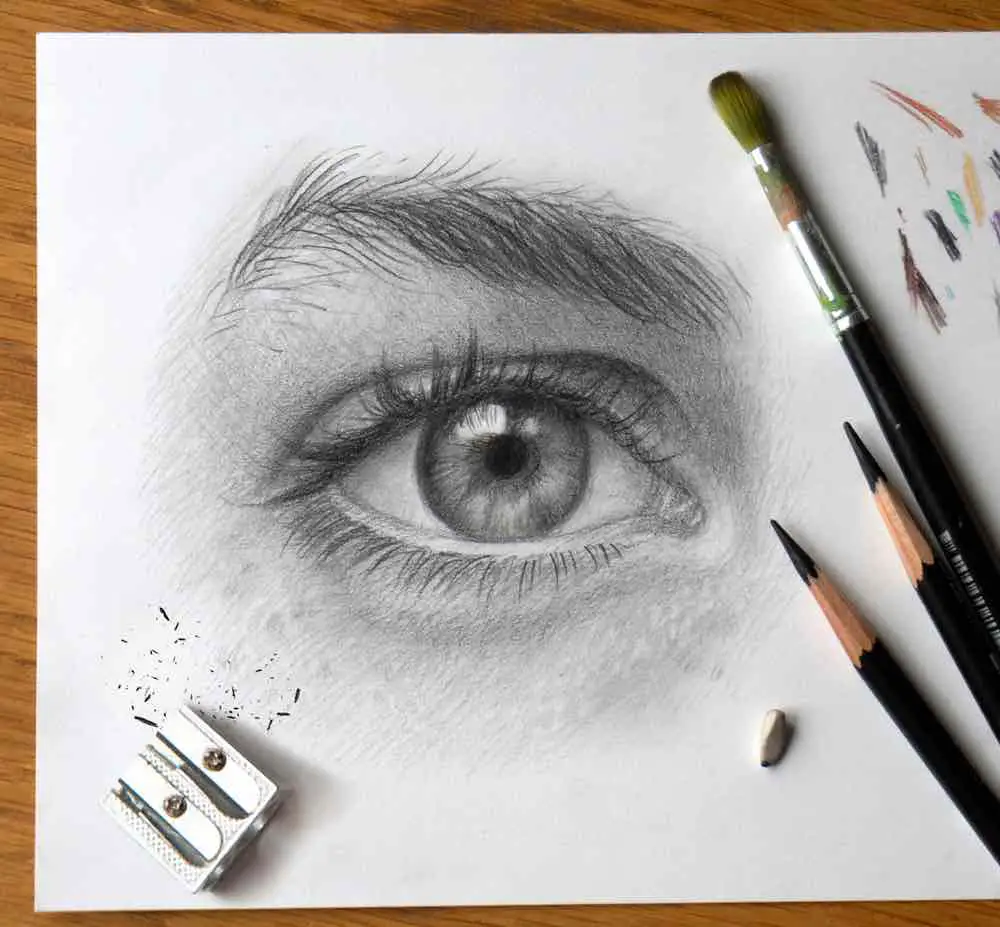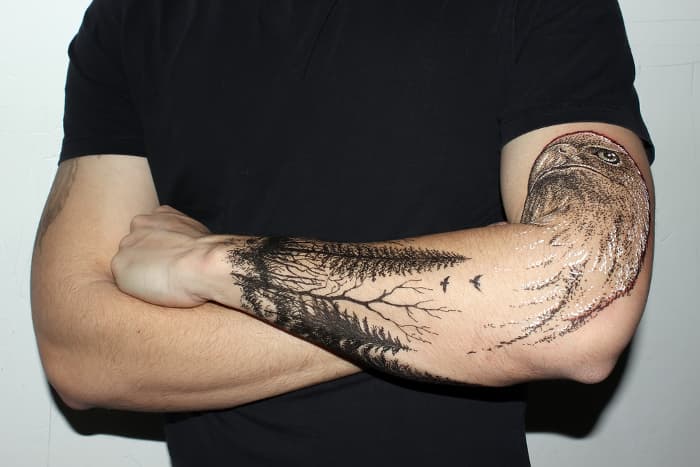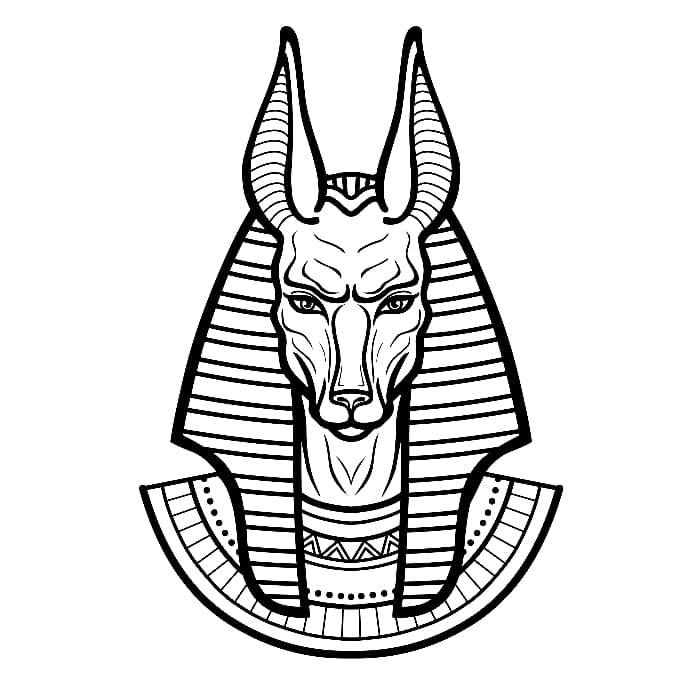Eye tattoos have been a popular form of body art for centuries, conveying a wide range of symbolic meanings and cultural associations. These intricate designs often represent protection, guidance, and truth, and have been embraced by individuals from diverse backgrounds and beliefs. Originating from ancient symbols such as the Christian “Eye of God” and the Egyptian “Eye of Horus,” they have evolved into a variety of artistic styles, linking spirituality and higher consciousness in the process.

As the art of eye tattooing has developed, so too have the numerous interpretations of their meanings and underlying symbolism. Some view eye tattoos as an expression of their inner truths and guidance, while others see them as a connection to the wisdom of ancient civilizations. The visual structure of the eye, with its intricate details and unique individual patterns, has also inspired countless tattoo artists to explore new and creative ways to depict this captivating symbol.
Key Takeaways
- Eye tattoos have diverse symbolic meanings, often linked to protection, guidance, and higher consciousness.
- These designs originate from ancient symbols, such as the Christian “Eye of God” and the Egyptian “Eye of Horus.”
- The intricate details of eye structure have inspired a variety of artistic styles in eye tattoos, each with its own unique interpretation and symbolism.
Origins and Symbolism
Eye tattoos have a rich history and carry various meanings depending on the design and the culture it originates from. One of the most famous eye symbols can be traced back to Ancient Egypt, known as the Eye of Horus, representing protection and life. In Christianity, the Eye of God or Eye of Providence symbolizes the ever-present watchfulness of God over the faithful.
All-seeing eye tattoos often denote wisdom or spiritual awakening, with the light source behind the eye representing illumination. This design is associated with the opening of the third eye in various spiritual and religious beliefs. A popular rendition of this symbol is the crying all-seeing eye tattoo, which adds an emotional aspect to the symbolism.
The third eye itself is a concept present in many spiritual traditions. It represents intuition, higher consciousness, and spiritual awakening. A tattoo depicting the third eye may symbolize the wearer’s quest for spiritual growth and self-discovery.
In modern times, eye tattoos have taken on more artistic interpretations, while still carrying the themes of duality, truth, trust, and knowledge. Different styles and elements can be incorporated into eye tattoo designs, such as combining the eye with animals, geometric shapes, or intricate patterns. The meaning behind these tattoos often varies from person to person, as some choose a design based on personal significance or an archetypal meaning tied to a specific culture or belief system.
Types of Eye Tattoos
Realistic Tattoos
Realistic eye tattoos capture the intricate details and lifelike appearance of an actual eye. These designs often showcase emotions, expressions, and even reflections within the eye. Eyeball tattoos, on the other hand, involve tattooing the whites of the eyes and are not recommended due to significant risks and potential complications.
Triangle Tattoos
Triangle eye tattoos are inspired by various symbolic meanings and often incorporate the eye within a triangle shape. The eye within the triangle represents multiple dimensions, including geometric designs, traditional styles, or abstract ideas. Triangle eye tattoos are diverse and can be modified to reflect personal beliefs or interests.
Spiritual Tattoos
Spiritual eye tattoos incorporate various spiritual symbols and meanings. One popular spiritual design is the Eye of Horus tattoo, an ancient Egyptian symbol of protection, royal power, and good health. Another widely recognized symbol is the “all-seeing eye” or “Eye of Providence,” which signifies divine guidance and is often associated with the Freemasons and Illuminati.
Cultural Tattoos
Cultural eye tattoos draw inspiration from different cultural backgrounds and traditions. These designs may include specific symbols, patterns, or styles unique to a certain culture or group. Examples of cultural eye tattoos include the “Evil Eye” from the Mediterranean and Middle Eastern regions, which is believed to protect against negative energy and harm. Other cultural eye tattoo designs might incorporate elements from tribal or indigenous art, such as Maori or Polynesian patterns.
Meanings and Associations
Eye tattoos have a wide variety of meanings and associations, stemming from various cultural and spiritual beliefs. One common theme is the representation of divine presence, such as the Eye of God in Christianity, signifying the ever-watchful eye of God over his faithful followers, or the Egyptian Eye of Horus, symbolizing protection, royal power, and health.
Many eye tattoos also convey a sense of guidance and providence, as the all-seeing eye is often seen as a benevolent force guiding humanity from a higher plane. This notion of higher guidance can be linked to wisdom, clarity, and intuition, as the watchful eye sees things with greater perception and understanding.
Duality and the passage of time are other themes often associated with eye tattoos. The eyes are sometimes depicted as a pair or in a mirrored design to represent the balance of opposing forces or the cyclical nature of existence. This may also tie into themes of enlightenment and spiritual awakening, as understanding the interconnectedness of all things requires both knowledge and introspection.
Eye tattoos also carry a sense of power, strength, and courage, as they serve as a connection to the divine and remind the wearer of their ability to overcome challenges and obstacles. They may symbolize the inner emotion and truth of the individual, conveying a sense of honesty and trust in one’s own abilities.
Themes of healing, care, and emotion can also be found in eye tattoos, as the watchful eye can be seen as a source of comfort and reassurance in difficult times. The all-seeing eye is often connected to the notion of life itself, providing a sense of purpose and spiritual guidance as one navigates their own unique path.
Finally, eye tattoos can hold elements of superstition and mysticism, as the symbols often contain esoteric meanings and hidden depths. This often appeals to those with an interest in the occult, spiritualism, or alternative faiths.
Throughout these associations, it’s clear that eye tattoos hold significant meaning and symbolism for those who choose to adorn their bodies with these powerful symbols. The diverse range of meanings and interpretations ensures that each wearer can find a personal, unique connection to their eye tattoo, making it a cherished and meaningful piece of body art.
Eye Structure and Tattoos
The human eye is a complex, intricate organ that enables us to perceive our surroundings, perceive colors, and enjoy visual experiences. An essential component of the human eye is the sclera, commonly known as the white part of the eye. It forms the outer layer of the eyeball and is key to maintaining the eye’s shape and structure. The cornea is an outer transparent layer of the eye responsible for focusing light onto the retina. The retina is the light-sensitive tissue at the back of the eye which helps in creating images that the brain interprets.
The lens, located behind the iris and the pupil, focuses light entering the eye onto the retina, resulting in clear images. The iris is the colored part of the eye that controls the amount of light entering the eye by adjusting the size of the pupil. The pupil is the black circular opening in the center of the iris that lets light pass through to the lens.
Eye tattoos typically involve injecting permanent ink onto the sclera. Known as scleral tattoos, these involve considerable risk and can lead to severe complications. It’s important to note that eye tattoo designs discussed in this section refer to tattoos representing an eye or an eye’s components, rather than injecting ink into the eye itself. These eye-related tattoos are imbued with various symbolic meanings and are often created with different artistic styles.
Since the eye is an integral part of human experiences, it’s no surprise that eye tattoos represent various emotions, meanings, and symbolism. These tattoo designs can be inspired by the intricate structure of the human eye or even the rich symbolism associated with certain eye-related elements such as the pupil, iris, or sclera.
Risks and Concerns
Eye tattoos, specifically eyeball tattoos, involve injecting ink into the sclera, or white part of the eye. While this form of body modification may hold cultural or personal significance to some individuals, it also comes with several risks and concerns in terms of health and safety.
One of the most common concerns with eyeball tattoos is the risk of infections. The eye is a delicate organ and introducing foreign substances, like ink, can potentially cause infections or introduce harmful bacteria. It’s essential to have a skilled and experienced professional perform this procedure; however, infections can still occur even in the best conditions. If an eye infection occurs, it’s crucial to seek treatment from an eye doctor immediately.
Inflammation can also occur as a result of the tattooing process. The injection of ink may cause an immune response in the body, leading to inflammation within the eye. This can lead to discomfort, redness, and sensitivity to light. In some cases, prolonged inflammation can cause damage to the eye and even vision loss.
Another significant risk associated with eyeball tattoos is retinal detachment. This occurs when the retina detaches from the back of the eye, typically due to trauma or injury. While retinal detachment is a rare occurrence, the tattooing process’s invasive nature increases the likelihood of this complication. Retinal detachment is a medical emergency that requires prompt attention to prevent permanent vision loss or blindness.
In extreme cases, eyeball tattoos can lead to blindness or severe vision loss. Damage to the eye’s various structures, including the cornea, lens, and retina, can compromise vision quality. Moreover, if complications worsen or are left untreated, the entire eye may be at risk. Consulting an eye doctor immediately if issues arise is critical to minimizing the risks associated with eyeball tattoos.
Cosmetic Body Modification
Eye tattoos are a form of cosmetic body modification that continues to gain popularity. These tattoos come in two main types: corneal tattooing and scleral tattooing. Each type involves injecting permanent dyes into different parts of the eye to alter its appearance.
Corneal tattooing, also known as keratopigmentation, has been practiced for centuries to improve the cosmetic appearance of corneal scars and leukomas. This procedure involves injecting dye into the cornea, the transparent front surface of the eye. While corneal tattooing has been used successfully to treat visual symptoms associated with corneal and iris abnormalities, it still carries risks, particularly when performed for purely cosmetic purposes.
Scleral tattooing, also known as scleral tattoos or eyeball tattoos, is a more recent and extreme form of cosmetic body modification. This procedure involves injecting permanent ink into the white part of the eye, known as the sclera, changing its color and appearance. Scleral tattoos are considered high-risk due to the numerous potential complications, such as infections, vision loss, and damage to the eye’s structure.
Apart from corneal and scleral tattoos, cosmetic tattooing is also used in other areas like covering up dark circles under the eyes, usually referred to as micropigmentation or permanent concealer. This technique is far less invasive than eye tattoos, as it focuses only on the skin and not on the eye’s delicate structures.
Though eye tattoos are related to traditional skin tattoos in terms of the process, they come with significantly higher risks due to the sensitive nature of the eye’s anatomy. The conjunctiva, a thin membrane that covers the sclera, can be easily damaged during the tattooing process, leading to infections and other complications.
Legal Aspects and Regulations
Eye tattoos, particularly sclera tattoos where the white part of the eye is inked, have been a subject of controversy due to the risks associated with the procedure. As a result, some states in the US have chosen to ban or regulate eye tattooing to protect public health.
In response to several cases of eye tattoos gone wrong, laws have been changed in a few states starting from the late 2010s. For instance, sclera tattooing is now prohibited in Oklahoma, Indiana, and Washington. These states have taken action to ban the practice mainly due to the serious consequences that can arise from the procedure, such as infection or even loss of vision.
Furthermore, in the broader context of tattoo discrimination, efforts have been made to protect individuals with tattoos from facing discrimination in various aspects of life. For example, in 2022, New York City Councilman Shaun Abreu introduced a bill that aims to amend the city’s administrative code, prohibiting employment, housing, and public accommodation discrimination based on having a tattoo.
The actual practice of tattooing, including eye tattoos, falls under the jurisdiction of local authorities. Thus, regulations can differ from one locality to another, which is essential for both tattoo artists and individuals interested in getting eye tattoos to be aware of the specific regulations in their area.
To recap, the legality and regulations surrounding eye tattoos vary depending on the specific state or locality. Some states, such as Oklahoma, Indiana, and Washington, have taken a firm stance against sclera tattooing, while legislation efforts have emerged in other places like New York City to protect tattooed individuals from discrimination. Understanding the applicable regulations and remaining knowledgeable about any potential changes is crucial for both tattoo artists and clients.
Cultural and Conspiracy Connections
Eye tattoos have significant cultural value and are often seen as symbols of protection, wisdom, and insight. In many cultures, the eye is believed to possess spiritual powers and is considered a representation of divine watchfulness. Apotropaic talismans, such as the Eye of Horus from ancient Egypt and the Hamsa Hand found in the Middle East, are used to ward off the evil eye and bring good fortune.
The Eye of Providence, or the all-seeing eye, is a popular motif in eye tattoo designs and is often associated with conspiracy theories and secret societies. This symbol depicts an eye within a triangle, typically with rays of light emanating from it. It is present on the back of the U.S. one-dollar bill and has been linked to the Illuminati, an alleged secretive organization believed to be in pursuit of a New World Order. However, the symbol’s origins can be traced back to Christian iconography, where it represents the eye of God watching over humanity.
In the realm of science and medicine, the works of Galen, a prominent Greco-Roman physician and philosopher, have also influenced tattoo symbolism. His concepts, such as the four humors (phlegm, blood, yellow bile, and black bile) and their correlation with the human temperament, have inspired various eye tattoos that signify balance and harmony of the body and soul.
While some eye tattoos may reflect historical and cultural connections, others may also have personal meanings for the wearer. Popular quotations, such as “real eyes realize real lies” attributed to Tupac Shakur, serve as a reminder of the importance of discernment and self-awareness.



